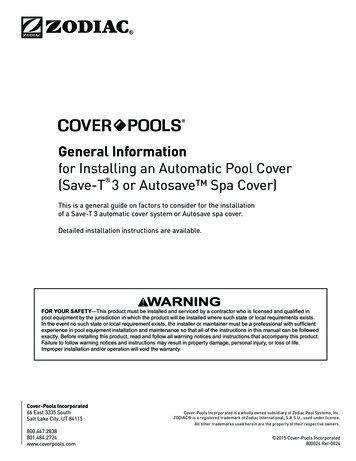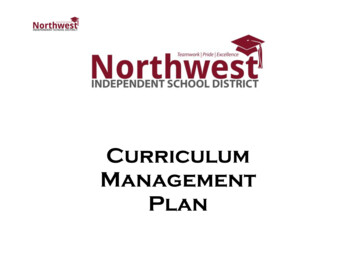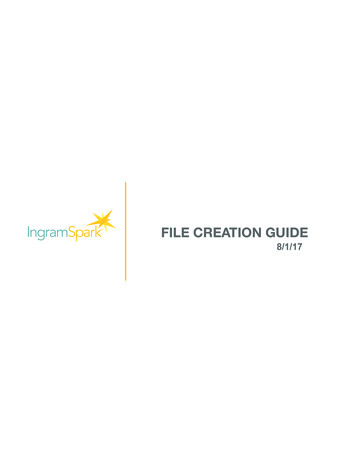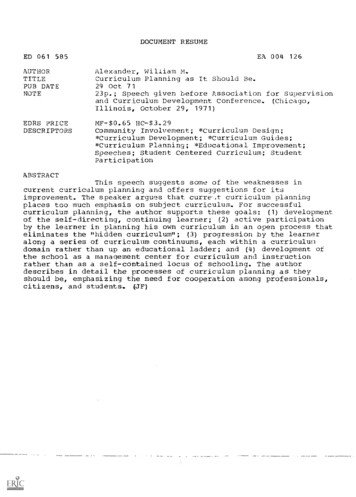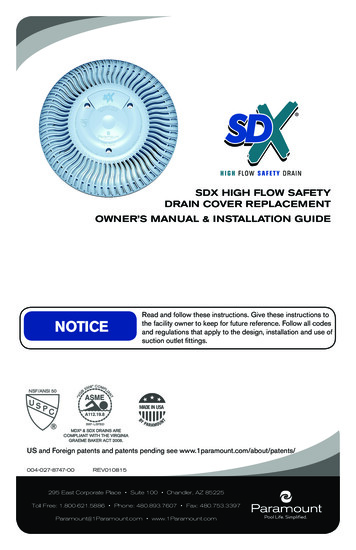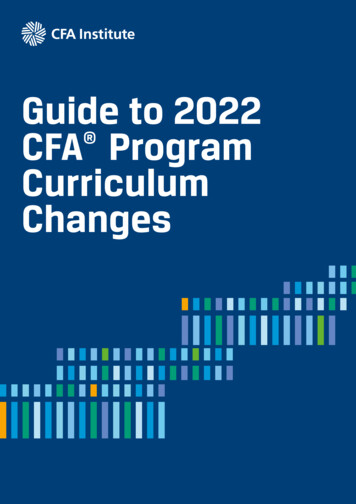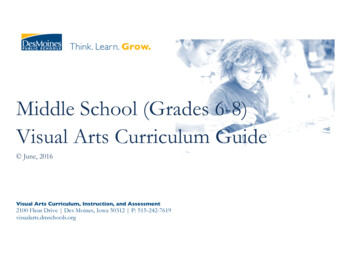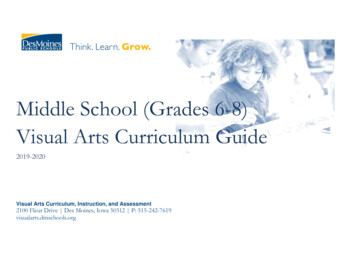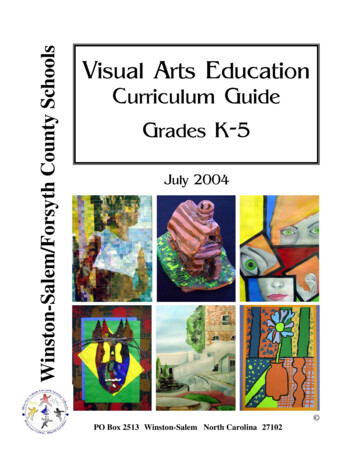
Transcription
Winston-Salem/Forsyth County SchoolsVisual Arts EducationCurriculum GuideGrades K-5July 2004 PO Box 2513 Winston-Salem North Carolina 27102
Winston-Salem/Forsyth County SchoolsInstructional Services1605 Miller StreetWinston-Salem, North Carolina 271032004 Winston-Salem/Forsyth County Schools thanks the students and their parents whohave granted us permission to reproduce the student artwork that appears in thiscurriculum guide. The student and the student’s parents own the copyright of theseworks of art. They may not be reproduced without the express written permission ofthe student and their parents.
Table of ContentsPreface. . . . . . . . . . . . . . . . . . . . . . . . . . . . . . . . . . . . . . . . . . . . . . . . . . . .Introductionii. . . . . . . . . . . . . . . . . . . . . . . . . . . . . . . . . . . . . . . . . . . . . . . . .iiiPhilosophy. . . . . . . . . . . . . . . . . . . . . . . . . . . . . . . . . . . . . . . . . . . . . . . . . .ivSection I:Scope and Sequence Guide . . . . . . . . . . . . . . . . . . . . . . . . . . . . .1DBAE (Discipline Based Art Education). . . . . . . . . . . . . . . . . . . .3Content of Art . . . . . . . . . . . . . . . . . . . . . . . . . . . . . . . . . . . .3Elements of Art . . . . . . . . . . . . . . . . . . . . . . . . . . . . . . . . . . .4Principles of Design. . . . . . . . . . . . . . . . . . . . . . . . . . . . . . . .7Creative Art Process . . . . . . . . . . . . . . . . . . . . . . . . . . . . . . . .9Drawing . . . . . . . . . . . . . . . . . . . . . . . . . . . . . . . . . . . . . . .9Painting . . . . . . . . . . . . . . . . . . . . . . . . . . . . . . . . . . . . . . .10Printmaking . . . . . . . . . . . . . . . . . . . . . . . . . . . . . . . . . . . .10Ceramics . . . . . . . . . . . . . . . . . . . . . . . . . . . . . . . . . . . . . .11Sculpture . . . . . . . . . . . . . . . . . . . . . . . . . . . . . . . . . . . . . .12Fibers. . . . . . . . . . . . . . . . . . . . . . . . . . . . . . . . . . . . . . . .13Section II: N.C. Visual Arts Competency Goals . . . . . . . . . . . . . . . . . . . . . . . . .15Kindergarten . . . . . . . . . . . . . . . . . . . . . . . . . . . . . . . . . . . . . .15Grade One . . . . . . . . . . . . . . . . . . . . . . . . . . . . . . . . . . . . . . . 29Grade Two . . . . . . . . . . . . . . . . . . . . . . . . . . . . . . . . . . . . . . .41Grade Three . . . . . . . . . . . . . . . . . . . . . . . . . . . . . . . . . . . . . . 53Grade Four . . . . . . . . . . . . . . . . . . . . . . . . . . . . . . . . . . . . . . .67Grade Five79. . . . . . . . . . . . . . . . . . . . . . . . . . . . . . . . . . . . . . .Section III:Assessment . . . . . . . . . . . . . . . . . . . . . . . . . . . . . . . . . . . . . . . . 93Section IV:Teacher Resources (Exhibit Dates, Labels, Handouts) . . . . . . . . . . .115Section V:Health and Safety . . . . . . . . . . . . . . . . . . . . . . . . . . . . . . . . . . . .161Section VI:EC/Special PopulationsSection VII:Multi-Cultural Resources . . . . . . . . . . . . . . . . . . . . . . . . . . . . . . . . . . . . . . . . . . . . . . . . . . . . . . . . . . . . . 165171Section VIII: Glossary and Bibliographies . . . . . . . . . . . . . . . . . . . . . . . . . . . . . 175
P R E F A C EThe Visual Arts Department of the Winston-Salem/ForsythCounty Schools has historically been in the forefront of visual artseducation. The foundation of this program is built upon a DisciplineBased Art Education (DBAE) approach.This method embraces fourcomponents: art history, art production, criticism, and aesthetics. TheDBAE approach is incorporated into every unit taught by visual artsteachers in this system and provides a strong backdrop for buildingsuccessful programming.This curriculum guide has been written to assist and inspirevisual arts teachers to use the North Carolina Standard Course ofStudy as the basis for developing the visual arts programming withinthe individual classroom. It has been formatted as a “living” documentin order to aid the teacher in developing a personal, useful binderwhile creating a comprehensive visual arts program within theindividual school setting.Numerous teachers representing many years of master teachingand experience have contributed to the development of this document.Their commitment to providing the most effective and timelydocument possible is gratefully acknowledged and deeply appreciated.Lynn W. FoltzVisual Arts Program Specialistii
INTRODUCTIONThe purpose of a balanced visual arts program is to reinforce,encourage, and meet the individual needs of our students from prekindergarten through the twelfth grade.Each developmental levelrequires special programming and attention to address the creativegrowth needs of our students. In order for visual arts teachers to bestmeet our students’ needs, this curriculum guide has been formatted tobe used as a “living” document which may be added to and enhancedas the needs of the teacher progresses.The focus of this document is based on a Scope and Sequencepacing guide to provide guidance for the age-appropriate introductionof methods, vocabulary, and techniques in the classroom.TheCompetency Goals of the North Carolina Standard Course of Studyare the backbone of this guide, which assures the development of abalanced curriculum.Other sections have been included to providefor the changing climate of education as the individual teacherprogresses in curriculum development.Many resources have beeninitially provided, but will be further enhanced as we address futureissues.Great effort has been placed on providing the most user-friendlydocument possible to assist the visual arts teacher in organizing acomprehensive and balanced curriculum.The No Child Left Behindlegislation has deemed visual arts as a core subject area. It is eachteacher’s task to incorporate the standards set by the state of NorthCarolina when developing the visual arts program in each individualschool.iii
WS/FCS Visual Art Education Philosophy“I do not want art for a few any more than education for a few, or freedom for a few.” William MorrisThe WS/FCS Visual Art Education Curriculum is the result of the effort of art teachers fromall levels in the county to create a “user-friendly” guide to the curriculum. This compilation of goalsfrom the NCDPI along with local recommendations addresses the articulation of visual literacy fromelementary through high school. The purpose of the curriculum is to provide art teachers with acommon reference point from which to plan, implement, and evaluate the instructional program forart education within their school. Art education for students on all levels is founded on a disciplinebased approach. It is the intent of this instructional program to integrate the study of art criticism,art history, aesthetics, and art production through the goals, objectives, and strategies proposed herein.The curriculum development committee intentionally focused on the shared vision of asequential approach to instruction K-12. The elementary art education program establishes a solidfoundation in the elements and principles of design for students. Middle school students who electto take art explore media and techniques while delving more deeply into art basics. All art coursesat the high school level are elective. Classes are intended to serve the needs of the beginner as wellas those of the individual who desires to develop a professional portfolio.Winston-Salem/Forsyth County Schools encompass 71 schools and serve approximately 45,500students. Demographic diversity is the norm. Our multi-cultural/racial community allows us tocelebrate the artistic achievements of a variety of peoples. Therefore, our curriculum creates learningopportunities from a variety of cultural perspectives. Consideration for accommodating students withspecial needs is the responsibility of all art teachers. These populations include exceptional children,gifted, ESL (English as a second language), and others. Teachers are expected to modify instructionto meet the needs and ability levels of all students.Art learning and experience involves the use of a wide range of mental processes as studentsmature in artistic expression and abilities. Gaining knowledge in art is a process, which includes:Perceiving, Communicating, Producing, Evaluating, Knowing, and Connecting. Each of these strandsis relevant across grade levels and provides unifying threads of understanding supported by the schoolsystem’s goals and objectives.We in the WS/FCS believe that all students are capable of achieving success in art.iv
Section I:Scope and Sequence GuideThis document provides a developmental sequencing, or pacing guidefor the purpose of determining when to introduce the elements andprinciples of design along with processes to students at age-appropriatelevels. The proper use of this sequencing guide will ensure a balancedDiscipline Based Art Education visual arts program.
Discipline Based Art EducationContent of Art“What a society deems important is enshrined in its art.” Harry BroudyArt MakingArt Forms: drawing, painting, ceramics,sculpture, printmaking, and fibersArt Forms: architecture, environmental art,technologyArt Forms: conceptual, videoForming Processes: media, tools,techniques, approaches, technologies, safetypractices, production, art makingK1-23-45-67-89-12Art HistoryContext: history, culture, society, artists,time, place, role, function, purpose, influence,style, genreStudy and Interpretation: perception,description, analysis, explanation,deconstruction, judgment, evaluation,meaning, message, reflection, criticismIdeational Aspects: idea, subject matter,symbols, metaphors, themes, conceptsForm, Qualities, and Styles: sensory,formal, expressive qualities, individual stylesArt CriticismStudy and Interpretation: perception,description, analysis, explanation,deconstruction, judgment, evaluation,meaning, message, reflection, criticismForm, Qualities, and Styles: sensory,formal, expressive qualities, individual stylesIdeational Aspects: idea, subject matter,symbols, metaphors, themes, conceptsAestheticsAffects and Effects: aesthetic experience,preferences, pleasure and pain, enjoymentand revulsion, appreciationTheories and Philosophies: questionsrelating to the nature and value of art, sourcesof aesthetic experience, imitationalism,formalism, expressionism, institutionalismScope and Sequence3
Artistic PerceptionElements of Art“So much information can be conveyed with just one line,and the slightest change in that line will create a totally different meaning.” Keith al awarenessEye-hand coordinationDirectionalityDefine shape / partition spaceLine quality / variety of mark makingExpressive qualitiesDescriptive qualitiesImplied linesLine as valueFunctions of line: pattern, texture, andmovementPsychological qualitiesShapeIdentify, nameDifferentiate between geometric and freeform shapeDifferentiate between shape and formSigns and symbolsFigure ground perceptionOrganic / naturalPositive / negativeOpen / closedCulturalAbstract / inventedExaggerate / distortMultiple viewsPsychologicalScope and Sequence41-23-45-67-89-12
Elements of Art“Art is not what you see but what you make others see.” Edgar DegasFormKIdentify / nameDifferentiate geometric and free formDifferentiate between shape and formOpen / closedFigure / groundOrganic and naturalVolume and massCultural / architecturalAbstract / inventedDistortion / exaggerationExpressiveMultiple viewsPsychological1-23-45-67-89-12SpaceOpen / closedPositive / negativeForeground, middle ground, & backgroundOverlappingSize relationshipsPositional / placementDepthOne-point perspectiveAtmospheric / aerialTwo-point perspectiveDesign / functionPicture planeForeshorteningMultiple views / ambiguousValueIdentifyDifferentiateLight / darkValue scale / tonalityEffects of lightExpressive qualitiesPsychological qualitiesAssigning black & white value to color valuesExpanding value range5Scope and Sequence
Elements of Art“The object of art is not to reproduce reality,but to create a reality of the same intensity.” Alberto GiacomettiTextureKExplore / sensoryIdentify / nameDifferentiateEnvironmental ultural useImpliedRelating to ideasPsychological qualitiesColorIdentifyDifferentiatePrimary / secondaryColor familiesTertiary / intermediateTransparent, translucent, opaqueTints / shades / tonesScience of color tyColor symbolismExpressive qualitiesPsychological qualitiesScope and Sequence61-23-45-67-89-12
Principles of Design“Every child is an artist.The problem is how to remain an artist once he grows up.” Pablo dial symmetryEnvironmental balanceAsymmetryIn sisSimilaritiesDifferencesOpposites (i.e. light/dark)Visual differentiation (i.e. dull/bright)Figure/ground (i.e. near/far)Emphasis/focal tRepetitionEnvironmental awarenessNaturalRelationships (music, art, dance, rnatingHarmony7Scope and Sequence
Principles of Design“Art is a step from what is obvious and well-knowntoward what is arcane and concealed.” Kahlil Gibran, A Handful of Sand on the ShoreMovementKPhysicalVisualDirection / eye movementOptical illusionSpeed / control1-23-45-67-89-12UnityRelationships of elementsRepetition of elementsEnvironmental awarenessDominanceSubordinationPsychological effectsVarietyVisual interestExploring differences / contrastingelements (i.e. size, color, etc.)“Blessed are they who seebeautiful things in humble placeswhere other peoplesee nothing.” Camille PissarroT. FlytheScope and Sequence8th8 Grade
Creative Art ProcessDrawing“Descriptive drawing is extremely valuable if part of your ultimate expression is description. It is not allthat valuable if that kind of describing is irrelevant to your ends.” Robert MotherwellDrawingK1-23-45-67-89-12Large drawing instruments, crayon, chalk,water-base markersColored chalk on wet and dry papersemphasizing expressive qualitiesBrush drawing on large surfacesLarge soft pencils stressing line and itsexpressive useStylus or pencils as a sgraffito toolMonochromatic drawing with a single mediumto achieve a variety of tonal qualitiesTactile qualities of chalkOverlapping and placementCutting letters with a free-hand approachSoft drawing media to achieve changes invalue and hue by blending, rubbing, andother techniquesPen and ink and charcoal on avariety of surfacesContour drawing of simple formsVaried approaches to drawing media throughthe use of the tip, point, side, variation ofpressure, blending, and drawing on roughand smooth surfacesFree, spontaneous sketchingVarious expressive qualities of lineBasic poster techniques using block lettersDrawing techniques to reproducesurface texturesLettering with felt tip or pen and inkLine to suggest volumeLinear perspective principlesDrawing techniques related to use of value tosuggest form, space, and focal pointScratch-board drawing techniquesA variety of non-traditional drawing toolsStroking, stippling, and cross-hatching9Scope and Sequence
Painting“A painting is never finished – it simply stops in interesting places.” Paul GardnePaintingTempera paintingMixing primary colors for new colorsPainting with varied tools (sticks, sponges,etc.)Watercolor painting technique; uniquequalities of the medium through washes, weton wet, and direct brush strokesCrayon-resist techniqueMixing of secondary colorsWatercolor with mixed media(crayon, tissue paper, etc.)Tertiary colorsTints, tones, and shades of colors throughthe discovery processAdditional color principles (complimentarycolors, analogous colors, intensity, and value)Acrylic painting techniquesPainting with a palette knife and brushesCanvas stretching and preparationOil painting techniquesAir brush techniques, masking, retouching,and illustrationPresentation techniquesPrintmakingSimple printing processes (stamping, foundobjects, vegetables, etc.)Rubbings to transfer imagesPrinting on various surfacesRelief and serigraphy printing (potato prints,string, paper / cardboard, stencil, etc.)Relief printing using simple incised blocks suchas Styrofoam; intaglioSerigraphy using positive and negative stencilsReduction prints and multiple-color printsOne-color serigraphy printing using simplescreen frames with wax or cut-paper stencilsEditions, signing, multiple print registrationSerigraphy techniques with screen prints usingprofilm, paper, tusche, glue, wax, thermal, orphoto stencil processesK1-23-45-67-89-12
Ceramics“The mind is not a vessel to be filled but a fire to be kindled” PlutarchCeramicsCeramic clay-forming processes includingrolling, joining, pinching, pullingSurface decoration processes includingimpressed design, drawing in clay, texturaltreatmentClay characteristics and originsNon-firing finishing processes includingpolish, stain, paint, burnishingKnowledge of firing processes includingelectric kiln, out door pit, etc.Decorating with glazesNon-clay materials to enhance function anddesignClay as simple ceramic jewelryForming processes pottery or sculptureincluding coil building, sling, slag, and drapeSlab processes including plaques, tilesPortrait sculpture and figure modelingDecorating processes including under glazepainting, glaze pouring, staining, glazecharacteristicsForming techniques including potter’s wheelthrowing, making spouts and lips, handlepulling, mold making, slip castingK1-23-45-67-89-12“Just as our eyes needlight to see,our minds needideas in order to create.” Nicole Malebranche 11Scope and Sequence
Sculpture“When I’m working on a problem, I never think about beauty.I think only how to solve the problem. But when I have finished,if the solution is not beautiful, I know it is wrong.” Richard Buckminister FullerSculptureConstruction using blocks, boxes, or othermodular unitsPaper construction including tearing, cutting,folding, bending, pastingModeling using ceramic clay (pinching,rolling, coiling, pressing, stamping, incising)Joining processes to include gluing andnailingForms from nature as sculptureArmatures covered with papier macheConstructions using armatures covered withmetal foils, papier mache, paris craft orplasterRelief casting with plasterMobiles using space, form, and movement3-D forming techniques using wire includingtwisting, bendingConstruction with joining processes inmultiple mediaLow relief by molding paper and fiber pulpsExplore complex modular compositions usingmixed mediaForming and carving processes includingmanipulation of wood, wax, plastic, plaster,and natural objectsBas-relief carvingCasting with metalAdvanced forming techniques to includecarving, centrifugal casting, vacuum forming,solderingAdvanced sculpture concepts to includeinstallations, conceptual pieces, earthworksSubtractive sculpture in stone and woodScope and Sequence12K1-23-45-67-89-12
Fibers“So I said to myself – I’ll paint what I see.What a flower is to me but I’ll paint it big and they will be surprised into taking time to look at it.I will make even busy New Yorkers take time to see what I see of flowers.” Georgia O’KeeffeFibersTactile qualities of the various fabricsA Variety of yarns and fabricsFabric decoration with drawing, painting,appliqué, etc.The source and use of natural dyesBasic paper weaving skillsWeaving on table and/or inkle loomsBasic stitching skills and techniquesWeaving on simple looms such as card,branch, and box loomsThread-pulling from burlap and reweavewith yarnFibers combined with other media suchas ceramicsForming from found and unconventionalfibers and materialsBasic quilting processesSculptural forms through the use offabrics and fibersTactile qualities of textiles throughstitching and weavingBasic tie-dye processesBasic batik processesAdvanced skills and techniques ofstitching such as the chain stitch andsatin stitchMacramé; techniqueWeaving on two-harness looms andmaking frame loomsBasic hooking techniquesWrapping and coiling techniquesSewing techniques in fiber designSculptural basket weaving techniquesTrapunto technique13K1-23-45-67-89-12Scope and Sequence
Section II: N. C. Visual Arts Competency GoalsThis curriculum guide was designed to help direct teachers throughoutthe county as they implement the State's visual arts competency goalsand objectives.This section is divided into four parts:“North Carolina Visual Arts Competency Goals”"What Every Student Should Know and Be Able to Do" provides ageneral list of skills and competencies that students are expected tohave learned during the school year.“Suggested Vocabulary for Appropriate Grade Levels and Courses”provides teachers with a list of art vocabulary and a sheet for theindividual teacher to add additional words and terms."Suggested Subject Matter and Correlation With Other Subject Areas"provides teachers with a resource to begin selecting the subject andthematic matter for lesson plans.
N.C. Visual Art Goals and Objectives(from the N.C. Standard Course of Study)CHECKLISTThis checklist can be used to help plan the focus of each lesson during the school year so thateach of the objectives listed will have been met by all grade levels. Many of the objectives willbe met more than once during the course of a school year.Make a copy of this checklist for each class as a method of recording the goals and objectivesas they are achieved throughout the year.Visual Art Curriculum Goal 1:The student will develop critical and creative thinking skills and perceptual awarenessnecessary for understanding and producing art.Visual Art Curriculum Goal 2:The student will develop skills necessary for understanding and applying media, techniques,and processes.Visual Art Curriculum Goal 3:The student will organize the components of a work into a cohesive whole throughknowledge organizational principles of design and art elements.Visual Art Curriculum Goal 4:The student will choose and evaluate a range of subject matter and ideas to communicateintended meaning in artworks.Visual Art Curriculum Goal 5:The student will understand the visual arts in relation to history and cultures.Visual Art Curriculum Goal 6:The student will reflect upon and assess the characteristics and merits of their workand the work of others.Visual Art Curriculum Goal 7:The student will perceive connections between visual arts and other disciplines.Visual Art Curriculum Goal 8The student will develop an awareness of art as an avocation and profession.
Jennifer MericleKindergarten Kind er gar tenVISUAL ARTSNorth Carolina Standard Course of StudyThe study of visual art begins in Kindergarten with the introduction of skillsand concepts that will be completely new for most children. Because ofthe children's different developmental levels when entering Kindergarten, itis expected that this year will emphasize joyful exploration and discovery:mastery is a process that will require repetition at subsequent grades.The emphasis at this grade level is on: Personal experience and/or imagination Exploring a variety of media to develop fine and gross motor skills Learning care and use of tools and materials Following safety rules Family, five senses, counting, and retelling stories in pictures Learning about a variety of artists and art forms, including architecture Art Elements: line, shape, colorStrands: Perceiving, Producing, Knowing, Communicating, Evaluating, Connecting15
KindergartenCOMPETENCY GOAL 1:The learner will develop critical andcreative thinking skills and perceptualawareness necessary for understandingand producing art.Objectives1.01Use immediate environment, including family, home andsurroundings, as source of ideas.1.02 Use imagination as a source of ideas.1.03 Understand and follow step-by-step presentation of artactivities.1.04 Begin to develop appropriate art vocabulary.1.05 Develop symbols for visual expression.1.06 Select color according to emotional appeal.1.07 Explore a variety of media.1.08 Create work that does not conform to adult standards ofrealism.1.09 Select artwork they "like the best" and simply explain why.1.10Illustrate poems, stories, and rhymes.1.11Use all the senses to gain information and awareness abouttheir environment.1.12Perhaps find inspiration from a variety of artwork.COMPETENCY GOAL 2: The learner will develop skills necessaryfor understanding and applying media,techniques, and processes.(National Standard 1)Objectives2.01Become familiar with a limited number of basic art media,techniques, and processes which may include:Drawing - crayons, oil pastels, non-toxic markers, brushes,computers, pencils, sidewalk chalkCut paper - glue, scissors, folding, bending, 3-D clay, paper,found objects, including wood scrapsPrintmaking - stamps, gadgets, found objects, vegetables, monoprintPainting - tempera, watercolors, large brushes, sponges, finger paintCeramics - pinch, coil, found stamps17
Kindergarten2.02 Explore media freely.2.03 Develop fine and gross motor control.2.04 Utilize entire page when using 2-D materials.2.05 Create a variety of lines, like thick and thin, curved orzigzag, etc.2.06 Cut large and small shapes; double layers to produce identicalshapes.2.07 Model clay by pressing, pulling, pinching, incising, stampingwith found objects.2.08 Create original pictures of self, others, animals, and objects.2.09 Render own thoughts and feelings visually.2.10Demonstrate proper use and care of materials and tools.2.11Use the art room rules for behavior, care and safety ofequipment, tools, and materials.COMPETENCY GOAL 3: The learner will organize the componentsof a work into a cohesive whole throughknowledge of organizational principles ofdesign and art elements.(National Standard 2)Objectives3.01Name and identify colors.3.02 Identify primary and secondary colors.3.03 Mix secondary colors.3.04 Identify different types of line: straight, crooked, curved,zigzag, wide, and thin.3.05 Recognize that line can be used to define contour of shapesand forms.3.06 Name different textures on surfaces, for example: rough,smooth, bumpy.3.07 Identify geometric shapes: circle, square, rectangle, triangle,diamond, and oval.3.08 Recognize some shapes have names; some do not.3.09 Begin to discuss his/her own work and that of others interms of color, line, shape, and texture.18
Kindergarten3.10Use the entire page as part of the composition.3.11Use solutions that do not rely on copying or tracing otherswork.3.12Recognize others may view or interpret differently.3.13Use his or her own ideas and feelings when creating artwork.3.14Respect the work of others when discussing art.3.15Explore a variety of materials.COMPETENCY GOAL 4: The learner will choose and evaluatea range of subject matter and ideasto communicate intended meaning inartworks. (National Standard 3)Objectives4.01Create art depicting self, family, friends, pets, home, school,and community.4.02 Demonstrate the use of life surroundings and personalexperiences to express ideas and feelings.4.03 Invent original and personal imagery from observation andimagination to convey meaning and not rely on copying ortracing another's work.4.04 Find inspiration in the work of other artists from manycultures.COMPETENCY GOAL 5: The learner will understand the visualarts in relation to history and cultures.(National Standard 4)Objectives5.01Recognize that people in many times and places havemade art.5.02 Recognize that art is created to fulfill personal and/orsocietal needs or purposes.5.03 Recognize that an artwork may serve functional purposes.19
Kindergarten5.04 Begin to relate to the concept of time personally ("when mygrandfather was young "), to famous people ("when GeorgeWashington was alive "), and units of time (day, week, years).5.05 Recognize that human beings create art to tell a story abouttheir ideas and lives without words.COMPETENCY GOAL 6: The learner will reflect upon and assessthe characteristics and merits of theirwork and the work of others.(National Standard 5)Objectives6.01Relate important experiences in life to one's own art.6.02 Accept others' work and ideas.6.03 Recognize that no two people are alike; therefore, theirartwork should not be alike.6.04 Begin to use art vocabulary for discussion.6.05 Begin to describe and explain his or her own art and theart of others in response to guided questions.6.06 Express one's feelings about a specific artwork.6.07 Begin to understand there are varied responses to specificart works.COMPETENCY GOAL 7: The learner will perceive connectionsbetween visual arts and other disciplines.(National Standard 6)Objectives7.01Make use of commonalties in the subject matter of visual artsand other disciplines.7.02 Begin to realize what each discipline encompasses.7.03 Begin to observe that objects can be handmade or machinemade and that both have value.7.04 Use current technology to learn about art and create one'sown artwork.20
KindergartenCOMPETENCY GOAL 8: The learner will develop an awarenessof art as an avocation and profession.Objectives8.01Develop a positive attitude about working with art materialsand the art making process.8.02 Understand that people of all ages can enjoy making artbased on shared knowledge of self, family, and friends.8.03 Begin to differentiate between man-made objects andnatural objects.21
What Every Kindergartener Should Knowand Be Able to DoTake pride in their own effortsShow acceptance of others’ effortsShow willingness to participate in doing, looking at, and discussing worksof artRecognize colors: red, yellow, blue, violet, green, orange, black, white,brown, gray, pinkRecognize different types of lines: straight, crooked, curved, zigzag, broken,etc. (Use lines to create shapes. Use lines to fill the paper. Learn to uselarge and small lines.)Recognize
The Visual Arts Department of the Winston-Salem/Forsyth County Schools has historically been in the forefront of visual arts education. The foundation of this program is built upon a Discipline Based Art Education (DBAE) approach. This method embraces four components: art history, art production, criticism, and aesthetics. The
